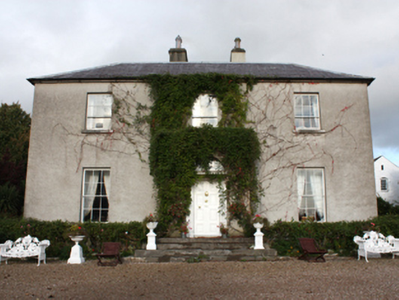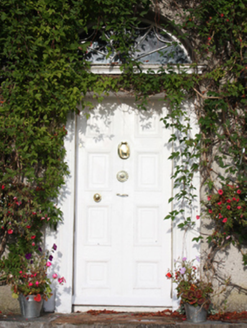Survey Data
Reg No
40820017
Rating
Regional
Categories of Special Interest
Architectural, Cultural, Historical, Social
Previous Name
Fahan Church of Ireland Rectory
Original Use
Rectory/glebe/vicarage/curate's house
In Use As
House
Date
1820 - 1825
Coordinates
234570, 426279
Date Recorded
15/10/2008
Date Updated
--/--/--
Description
Detached three-bay two-storey over basement former Church of Ireland rectory, built 1822, having central projecting single-bay single-storey entrance porch to the front elevation (south-west), and with two-storey returns and two-storey extension to the rear (north-east). Now in use as a private house. Hipped slate roof (on U-shaped plan having central valley, having , leaded roll ridge, central pair of cement rendered chimneystacks with stepped cap and some original octagonal clay pots, projecting cut stone eaves course, and with cast-iron rainwater goods. flat-roof to extension to rear. Roughcast rendered walls with plain ashlar stone stringcourse between basement and ground floor levels to front and side elevations (north-west and south-east). Square-headed window openings with smooth rendered reveals, stone and rendered stone sills, and with six-over-six pane timber sliding sash windows at ground floor level, and six-over-three pane timber sliding sash windows at first floor level to the front elevation; variety of timber sliding sash windows to other elevations. Central round-headed entrance door opening having timber panelled with bolection mouldings, doorcase comprising fluted timber pilasters supporting plain painted timber architrave and projecting moulded cornice over, and with spider’s web fanlight over; door addressed by tapering flight of ashlar stone steps with cement rendered sides. Set back from road in extensive mature grounds to the south-east end of Fahan and to the south-east of associated church (see 40820014). Detached four-bay two-storey outbuilding to the north-east having pitched natural slate roof, painted rubble stone walls, shallow segmental-headed window openings at ground floor level with fixed-pane timber windows, square-headed window openings at first floor level having multi-pane timber windows, square-headed doorway with battened timber door, and square-headed carriage-arch with battened timber double-doors. Detached single-storey outbuilding to the north-east of two-storey outbuilding having pitched corrugated-metal roof, painted rubble stone walls, and square-headed openings. Rubble stone boundary walls to the west and to the north-west of site having rubble stone soldier coping over. Modern or rebuilt stone-clad wall and gateway to south-western and north-eastern boundary of site having reused wrought- and cast-iron gates and railings. Wrought- and cast-iron double-gates to north-east of site. Gateway to the north of site having wrought-iron flat bar gates.
Appraisal
This well-proportioned former Church of Ireland rectory, of early nineteenth-century dates, retains it early character and form. Its visual expression and integrity is enhanced by the retention of much of its early fabric including natural slate roof and timber sliding sash windows. The good-quality doorway with fanlight to the porch, provides an attractive central focus to the main elevation. This building is an example of the language of classical architecture stripped to its barest fundamental elements, which creates a fine dwelling in a subtle style. This is exhibited through features such as the rigid symmetry to the main elevation, the central doorway, and the window openings that diminish in scale towards the eaves. The tapering flight of cut stone steps to the front door give it an extra emphasis. The three-bay two-storey form is typical of Church of Ireland rectory buildings (particularly those built by the Board of First Fruits), and many middle class gentleman's residences, dating from the late-eighteenth and early-nineteenth century. Lewis (1837) records that it was built in 1822 by aid of a gift of a £100 from the Board of First Fruits. This building is of social interest to the local community as a Church of Ireland rectory, and forms part of a pair of related sites along with the associated Church of Ireland church to the north-west (see 40820014). Situated in attractive mature grounds formerly overlooking Lough Swilly to the south-west, this building is an integral element of the built heritage of the local area. The simple outbuildings to the rear, particularly the two-storey outbuilding to the north-west, the surviving sections of rubble stone boundary wall, and the cast-iron and wrought-iron gates and railings to site, add considerably to the setting and context is this notable composition. This building was the home of the Revd. William Hawkshaw in 1846 (from 1837 at latest, Lewis), the Revd. John King in 1881 and a Revd. William A. Dickson in 1894 (all Slater’s Directory). A Revd. Richard Hawkshaw may also have been rector here in the 1830s or 1840s. A plaque to the associated church records that it was built in 1820 by the Revd. William Knox who was probably the first resident at this rectory when it was built in 1822. A modern plaque to the rear of this rectory records that this was home of the noted hymn writer Mrs. Cecil Francis Alexander (1818-95) lived here at some stage during the mid-to-late nineteenth century, probably as her husband, Revd. William Alexander, was a rector here at some stage. She was responsible for writing the well-known hymn ‘All things bright and beautiful’.







